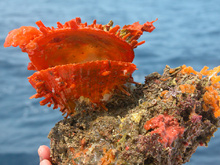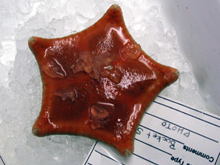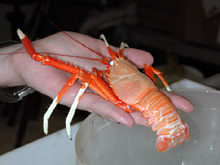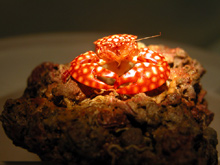
This spiny oyster and conglomerate exemplify the composition of live- bottom habitats on the Outer Shelf hard grounds. Photo Credit: Liz Baird. Click image for larger view.
Invertebrate Fauna on the Outer Shelf and Lophelia Banks
August 19, 2003
Martha Nizinski, PhD
Zoologist
NOAA National Marine Fisheries Service
National Systematics Laboratory
Weather has been dictating our schedule on the “Life on the Edge” expedition, and we have moved from the Lophelia banks to the outer continental shelf. Trawl and surface samples are being collected and Johnson-Sea-Link II manned submersible operations are being conducted whenever possible. All these data add to our working knowledge of marine community composition, species distribution, and microhabitat associations. While submersible collections are extremely important because they document microhabitat utilization and behavioral ecology, these collections are limited to one or a few individuals at a time. Trawl samples and surface samples complement our submersible collections because the large nets can collect larger quantities of individual specimens.

This pillow star is one type of sea star collected during the Johnson-Sea-Link II dive in the Stetson area Lophelia beds. Photo credit: Margot Bohan. Click image for larger view.
The first two dives of the expedition were on the Stetson area Lophelia sites. These areas are very different from the Lophelia banks we examined during a previous mission. In contrast to the large banks comprised of extensive mounds of coral, the Stetson Lophelia areas consist of smaller clumps of coral that are patchily distributed over the substrate. Sponges and soft corals also occur here and are distributed like the corals. Few mobile invertebrates were observed, although we had the good fortune to collect a portunid crab during one of the dives that we had previously captured only on video. Having a specimen to examine in the laboratory makes it much easier to verify a species' identity. During these dives, we also collected two types of sea stars and one species of sea urchin that we have not collected in the Lophelia sites before.
We also collected a squat lobster (Eumunida picta), a fairly common species found around Lophelia. The squat lobster appears to be a dominant component of the deep-reef fauna, but we know very little about its basic biology.

The squat lobster appears to be a dominant component of the deep-reef fauna off North Carolina. Photo credit: Margot Bohan. Click image for larger view.
A few studies have reported on its abundance, size frequency, sex ratio, and the occurrence of ovigerous (egg-bearing) females. Collection of additional specimens and in-situ observations help us gain a better understanding of population structure and behavioral ecology. For example, squat lobster adults are often found perched high on the reef with their claws extended above the reef. We have identified this stance as predatory behavior, but it may serve multiple functions. Also, we have collected smaller individuals in the rubble zone adjacent to the coral banks. Are these squat lobsters distributed by size? Are microhabitat requirements different for juveniles and adults? The more data we collect, the closer we come to answering such fundamental questions.

Porcelain crabs like this one possess a unique filter-feeding mechanism. Scientists retrieved this one via a suction while in the Johnson-Sea-Link II. Photo credit: Liz Baird. Click image for larger view.
The collections taken at the outer shelf hard grounds contain a mixture of familiar species and several species that we have not collected in these areas before, including a porcelain crab. Several crustacean species that we collected at the outer shelf stations are the same species we collected in the Gulf of Mexico earlier this year. Several studies on crustaceans have shown that populations in the Gulf differ from those on the Atlantic coast. These collections will provide great comparative material.
With the data collected at each station, we continue to add to our knowledge and gain a better understanding of community composition, size frequency distribution, and microhabitat associations. Repeat observations, digital photography, additional hours of video footage, and collection of more material all add pieces to the complex puzzle that is our marine world.





















